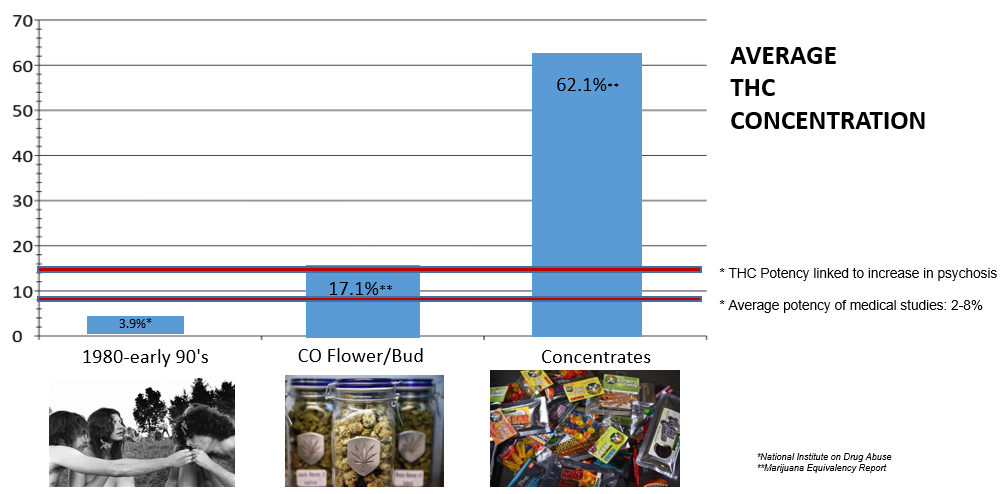 Despite the claims of pot-industry lobbyists that legalisation will not affect young adult and youth use, the data show that with legalisation and normalisation, people are radically increasing their rate of consumption. As commercialisation increases in legalised states, false advertising of marijuana products as being “natural” and “healthier than alcohol and tobacco” have greatly decreased the perceived risk of harm related to marijuana use. The main psychoactive ingredient in marijuana, THC, has now been observed to cause many different types of mental and physiological health problems— especially in children and youth.
Despite the claims of pot-industry lobbyists that legalisation will not affect young adult and youth use, the data show that with legalisation and normalisation, people are radically increasing their rate of consumption. As commercialisation increases in legalised states, false advertising of marijuana products as being “natural” and “healthier than alcohol and tobacco” have greatly decreased the perceived risk of harm related to marijuana use. The main psychoactive ingredient in marijuana, THC, has now been observed to cause many different types of mental and physiological health problems— especially in children and youth.
Their hopes and dreams literally go up in marijuana smoke.
The problem with liberal drug policies like legalisation is that they centre upon the rights of the user, at the expense of the most vulnerable party in the community, the child. Article 33 of the Convention on the Rights of the Child reads as follows:
States Parties shall take all appropriate measures, including legislative, administrative, and educational measures to protect children from the illicit use of narcotic drugs and psychotropic substances, as defined in relevant international treaties, and to prevent the use of children in the illicit production and trafficking of such substances.
Stephan Dahlgren, a Swedish lawyer who has been working for international organizations including UNICEF on human rights, children’s rights , and home affairs since 1994, says “This means that human rights law is requesting from all states that the protection of the child from ever getting in contact with drugs shall be the prism through which national and international drug policy shall be crafted.”
December 2020:
US state-level data from the National Survey on Drug Use and Health, the most authoritative study on drug use conducted by the Substance Abuse and Mental Health Administration (SAMHSA), has found significant increases in youth cannabis use in several recently legalised marijuana states versus last year. At the same time, mental illness indicators worsened across the country while alcohol, cocaine, and tobacco use dropped, especially among young people.
According to the data, adolescents aged 12-17 using marijuana in the past year significantly increased versus last year in the legalised states of Nevada, Oregon, and California. All other legal states showed increases as well, but versus last year they did not reach statistical levels of significance.
Nevada experienced a 17.4% increase, while Oregon and California witnessed increases of 15.4% and 14.5%, respectively. These increases were not witnessed in non-legal states. In non-legal Virginia and New York, adolescent past year marijuana use significantly fell, as it did in the non-legal Southern region of the United States.
The data additionally show a statistically significant 25.5% increase in past-month use in California among those aged 12-17.
The data also show us that youth use in states that have “legalised” marijuana far outstrips use in states that have not. Past-month marijuana use among young people aged 12-17 in “legal” states is 54.5% higher than past-month marijuana use among 12-17-year-olds in “non-legal” states (10% versus 6.47%). Past-year marijuana use among this age group in “legal” states is 41% higher than that of 12-17-year-olds in “non-legal” states (17.12% versus 12.14%).
Use among young adults aged 18-25 skyrocketed, especially in legal states.
https://www.samhsa.gov/data/sites/default/files/reports/rpt32806/2019NSDUHsaeShortTermCHG/2019NSDUHsaeShortTermCHG/2019NSDUHsaeShortTermCHG.pdf
COLORADO
- college age marijuana use increased 18% and is 48% higher than the national average
- youth marijuana use decreased 14% but is still 40% higher than the national average. First time use in Colorado ranks highest in the USA for 12-17 and 18-25 age groups. There is also a concerning increase in the use of high-THC dabbing and edibles amongst young teenagers (Rocky Mountain High Intensity Drug Trafficking Area 2019)
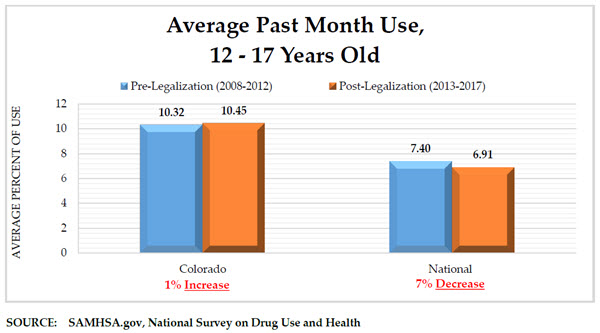
And once again, it’s not just around ‘smoking a joint’. One recent study showed increased use by 14–18 year olds with newer forms of consumption—vaping and edibles. Another study conducted in Oregon found that as medical marijuana users and growers increased in a community, marijuana use among youth also increased, in part because of social acceptance of the drug.
EFFECT ON YOUNG PEOPLE
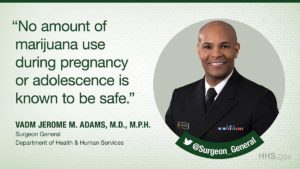 New Zealand has some of the richest data on the adverse consequences of cannabis use coming from two major studies: the Christchurch Health and Development Study (CHDS) and the Dunedin Multidisciplinary Health and Development Study (DMHDS).
New Zealand has some of the richest data on the adverse consequences of cannabis use coming from two major studies: the Christchurch Health and Development Study (CHDS) and the Dunedin Multidisciplinary Health and Development Study (DMHDS).
The CHDS is a study of a cohort of 1265 children born in 1977 who have been studied to the age of 35. The study has now published 30 scientific papers on the issue of cannabis. This research shows that:
* Cannabis use by cohort members was common, with over 75 per cent reporting use, and in the region of 15 per cent developing a pattern of heavy use and dependence at some point.
* The use of cannabis was associated with increased risks of a number of adverse outcomes including: educational delay; welfare dependence; increased risks of psychotic symptoms; major depression; increased risks of motor vehicle accidents; increased risks of tobacco use; increased risks of other illicit drug use; and respiratory impairment. These effects were most evident for young (under 18-year-old) users and could not be explained by social demographic and contextual factors associated with cannabis use.
It’s called ‘dope’ for a reason.
The United Nations Office on Drugs and Crime (UNODC) reported on the New Zealand study which found that cannabis is linked with dropping out of school, and subsequent unemployment, social welfare dependence, and an overall feeling of inferior life satisfaction compared to non‐cannabis using teens. These results remained significant even after controlling for family socio‐economic background; family functioning; exposure to child abuse; childhood and adolescent adjustment; early adolescent academic achievement; and comorbid mental disorders and substance use.
Teen: Colorado voters were duped into legalizing recreational marijuana
“It’s [marijuana industry] all so misleading, and there’s a lot of trickery going on because there are big money and politics in this and not enough people standing up to do the right thing because they’re afraid of losing something — like money, power, privilege or image. I compare it to Big Tobacco and bogus 1950s ads pushing everyone to smoke cigarettes — you know, as an expression of personal freedom and with a mythical 9 out of 10 doctors saying it’s all right. Only this time, it’s not just a buzz from some nicotine we’re talking about. Weed is a psychoactive, mind-altering substance. It is addictive. And I don’t care what anyone says; it is being marketed to kids.”
Nineteen-year-old Kaleb is 41 days and seven hours sober from his marijuana addiction (2015)
But isn’t alcohol as bad? In a study just published this year, scientists at the University of Montreal found that marijuana affected teenagers’ long-term cognitive abilities more than alcohol use. And even after students reported stopping cannabis use, their cognition did not improve.
MENTAL HEALTH
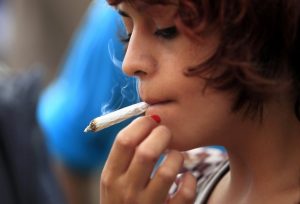 Direct associations have been made between the frequency of marijuana use and higher THC potency with the development of mental health issues (psychosis, depression, anxiety, suicidality, reshaping of brain matter, and addiction).
Direct associations have been made between the frequency of marijuana use and higher THC potency with the development of mental health issues (psychosis, depression, anxiety, suicidality, reshaping of brain matter, and addiction).
Daily marijuana use among youth who begin before the age of 17 significantly increases the risk of suicide attempts. Researchers led by the National Drug and Alcohol Research Centre at the University of New South Wales (and including New Zealand researchers) analysed results of three large, long-running studies from Australia and New Zealand involving nearly 3,800 people. Teenagers who start smoking cannabis daily before the age of 17 are seven times more likely to commit suicide, a study has found.
“The link between cannabis and psychosis is quite clear now; it wasn’t 10 years ago.”
Professor Colin Blakemore, chief of the Medical Research Council (UK) (2007)
Colorado toxicology reports show the percentage of adolescent suicide victims testing positive for marijuana has increased. (Colorado Department of Public Health & Environment [CDPHE], 2017).
In a longitudinal cohort study of young adults (n = 591) from Switzerland over 30-years, reported in 2020, cannabis use during adolescence was associated with depression and suicidality in adult life. Young age at first use and high frequency of use in adolescence may particularly increase the risk of depression in adulthood. (J Affect Disord. 2020;272:98‐103. doi:10.1016/j.jad.2020.03.126)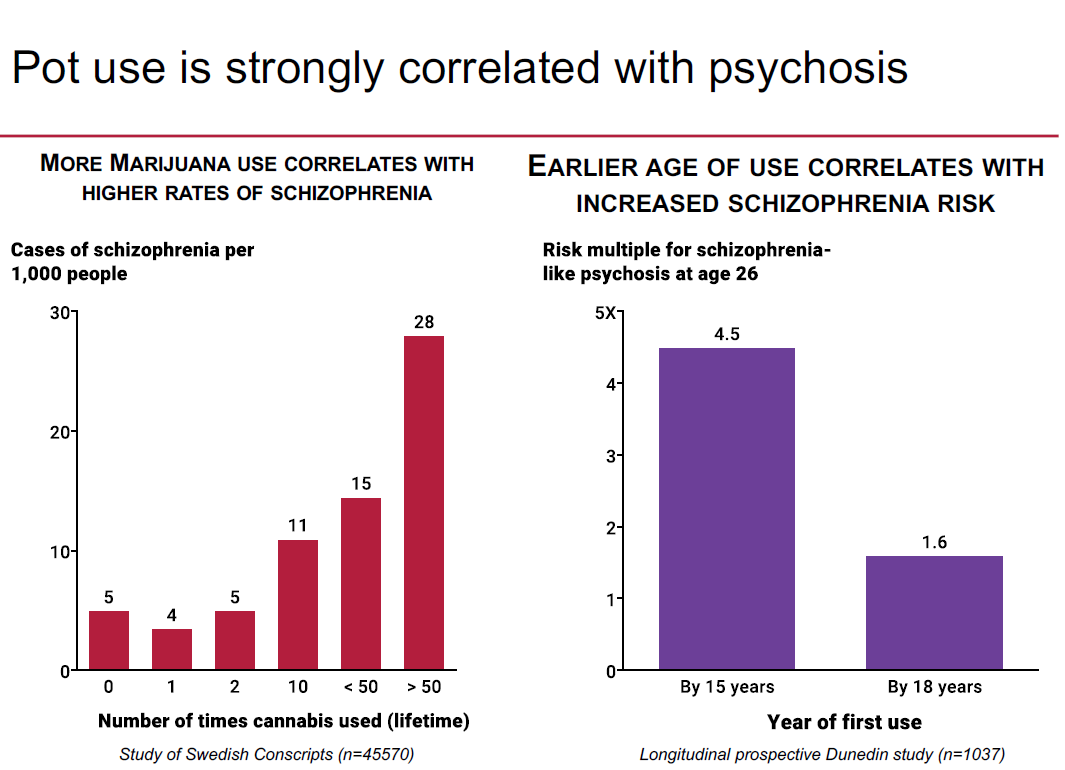
YOUTH USE CONCERNING BECAUSE OF CO’S UNPRECEDENTED HIGH-THC MARIJUANA
HOSPITALISATION
The number of teenagers sent to emergency rooms more than quadrupled after marijuana was legalised in Colorado — mostly for mental health symptoms, researchers reported in 2017.
A study conducted in Washington State found that the rate of pediatric exposures to marijuana (children aged 9 or under) was 2.3 times higher following retail sales than it was before legalization (Thomas, et al., 2019).
In Oregon, for children 5 years or younger, the number rose by 271% from 14 cases in 2014 to 52 cases in 2017 (Oregon Poison Center, 2018).
A 9 y/o child in the US state of New Mexico suffered a bad reaction after mistaking her parent’s medical marijuana gummy bears for regular lollies and sharing them with her friends at school. Four students at the Albuquerque School of Excellence ingested the gummies and suffered sickness, including one child who passed out on the floor.
Pot-laced Oreos send Oregon students to hospital.
Mail Tribune 19 Oct 2018
“There is no question marijuana can be addictive; that argument is over. The most important thing right now is to understand the vulnerability of young, developing brains to these increased concentrations of cannabis.”
Nora Volkow, director of the National Institute on Drug Abuse
In the UK, more than 125,000 hospital admissions have taken place over the past five years as a result of taking cannabis – including 15,000 teenagers – some of whom were rushed to hospital suffering from serious psychosis. The levels of admissions in England have jumped by more than 50% since 2013.
EFFECT ON TEEN ATTITUDES TO DRUGS
A 2017 survey found that one in four U.S. high school seniors would try marijuana or use it more often if it was legal. – the highest in the 43-year history of the Monitoring the Future survey. Broken down, about 15% of 12th graders said they would try marijuana if it was legal. And about 10% of current users said they would use it more often.
HIDDEN BIG MARIJUANA PRODUCTS
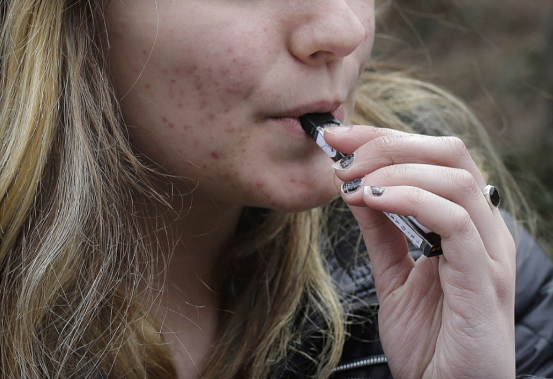 Students say vaping is everywhere and ‘it’s easy to hide’.
Students say vaping is everywhere and ‘it’s easy to hide’.
Researchers at the Centers for Disease Control and Prevention (CDC) surveyed some 20,000 students in grades 6-12 about their marijuana use in e-cigarettes. They found that nearly 1 in 11, or 2.1 million middle and high school students used marijuana in e-cigarette devices. In legal states people can buy cartridges of high-potency cannabis oil that fit into many e-cigarette devices. The popular Juul does not make marijuana pods, but users can refill Juul’s nicotine cartridges with cannabis oil.
A US study this year found that teens who used e-cigarettes and hookah were up to four times more likely to use marijuana later, according to a study published in the journal Pediatrics.
A RAND Corporation study just published by the journal Drug and Alcohol Dependence found that adolescents who view more advertising for medical marijuana are more likely to use marijuana, express intentions to use the drug and have more-positive expectations about the substance, providing the best evidence to date that an increasing amount of advertising about marijuana may prompt young people to increase their use of the drug.
According to the University of Michigan Monitoring the Future survey of American youth, between 2017 and 2018, the percentage of 8th and 10th graders who report “vaping” marijuana has increased 63%. Over the same timeframe, the percent of 12th graders who report vaping marijuana has increased by 53% (Johnston, Miech, Bachman, Schulenberg, & Patrick, 2018). Studies show youth vaping of any kind increases the risk of future marijuana vaping, presenting another risk amid a youth vaping epidemic (Kowitt et. al., 2019). Young people report vaping marijuana in increasingly large numbers since such data was first recorded in 2017 (Monitoring the Future, 2019).
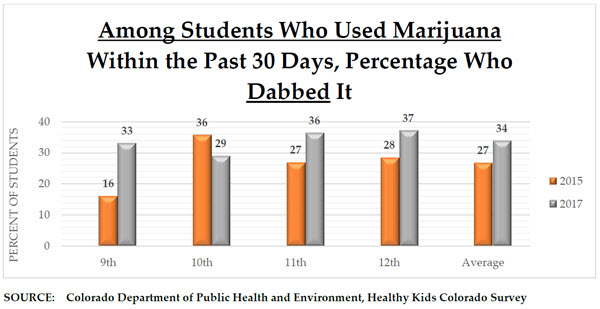
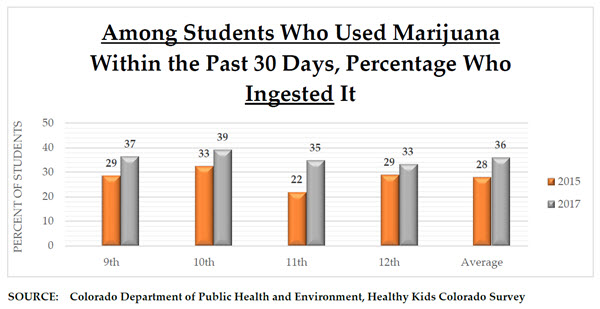
LATEST DATA (Colorado – August 2020)
A new survey just released by the state of Colorado has found that marijuana use has increased in the last two years with nearly 21% of young people in the state reporting past month use. Notably, use in young teens (aged 15 and younger) has significantly increased by 15.5% from 2017 (the last time data was collected).
According to the data, part of the Healthy Kids Colorado Survey, since 2017, past month marijuana use among those aged 15 or younger has increased 14.8%, 16 or 17-year-olds has increased 3.0%, and 18 or older has increased 1.9%. Overall, marijuana use amongst all age groups has risen 6.2%.
In a disturbing development, teens report an alarming increase in their use of ultra-potent cannabis products in the form of dabs and vapes. More than half of high school students (52%) who use marijuana reported that they dab marijuana to get high – up from 34.4% just two years ago. This is based on surveys of over 53,000 middle and high school students statewide in Colorado last year.
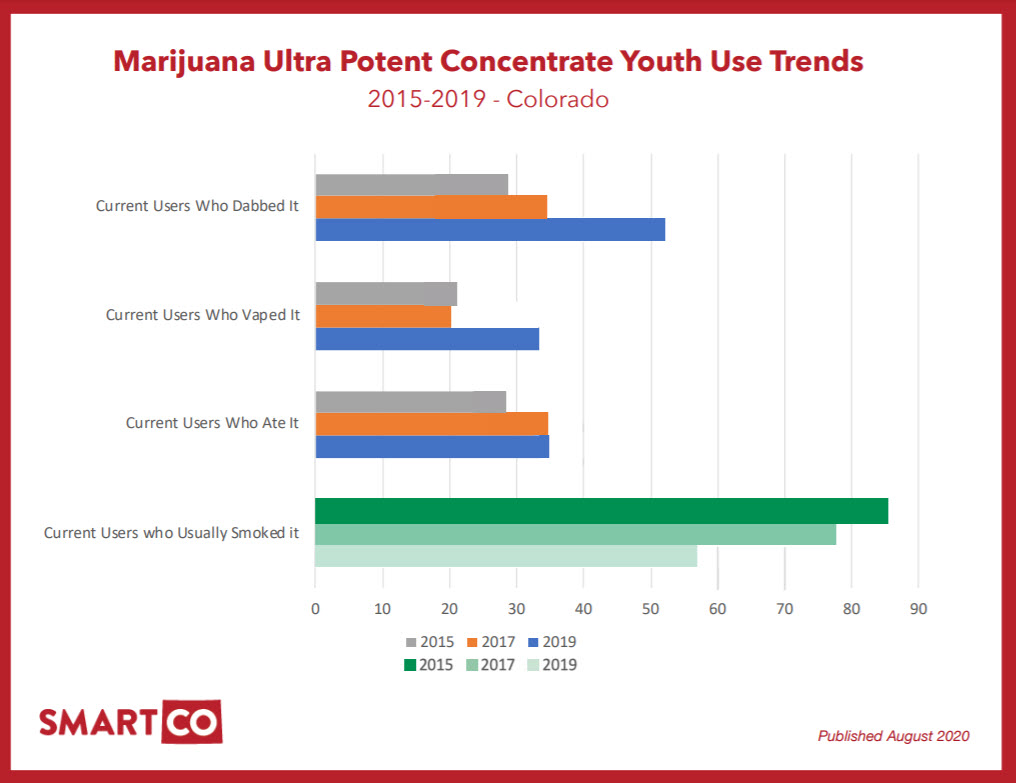 New Zealand teens are aware of the risks. Rajshan Featonby (16) is checking himself into a drug rehab clinic after being on various drugs for four-years.
New Zealand teens are aware of the risks. Rajshan Featonby (16) is checking himself into a drug rehab clinic after being on various drugs for four-years.
“I was about 10-years-old when I ended up with CYFS, I was about 12 when I had my first toke of marijuana and I was 13 when I had my first toke of synthetic cannabis.”
PATHWAY TO OTHER DRUGS
In 2017 researchers examined data from 17,000 youth aged 12-17 who participated in the 2014 National Survey on Drug Use and Health. Compared with youth without past-month marijuana use, youth with past-month marijuana use were 9.9 times more likely to report past-month use of other illicit drugs.
SELLING TO MINORS
It is illegal for youth to purchase marijuana in “legal” states. Among Oregon 11th graders who currently use marijuana, 67% reported obtaining marijuana from a friend (Oregon Public Health Division, 2016). Furthermore, 37.2% of 8th and 49.5% of 11th graders reported being exposed to online marijuana advertisements in the past 30 days (Oregon Health Authority, 2018). 30% of 8th and 62% of 11th graders
reported that it is “sort of easy” or “very easy” to obtain marijuana (Oregon Public Health Division, 2016).
Additionally, marijuana dispensary density has been linked to more use among youth, with 16% of 11th graders reporting marijuana use in areas with less dispensary density compared to 24.3% of the same age group reporting use in more retail-dense areas (Hatch, 2017). Washington State law enforcement has documented a total of 2,887, violations among licensed marijuana businesses. Of these, 251 violations pertained to selling marijuana to minors and 231 violations were for allowing minors access to a restricted area (Washington State Liquor and Cannabis Board).
In January of 2018, the Oregon Liquor Control Commission conducted a random inspection of licensed marijuana retailers and found that 11% of the businesses were selling marijuana to minors (Oregon Liquor Control Commission, 2018).
Marijuana social media marketing increased in “legal” states (Whitehill et. al., 2019). One study found young people who are exposed to marijuana marketing on social media are five times more likely to use marijuana (Trangenstein et. al., 2019).

